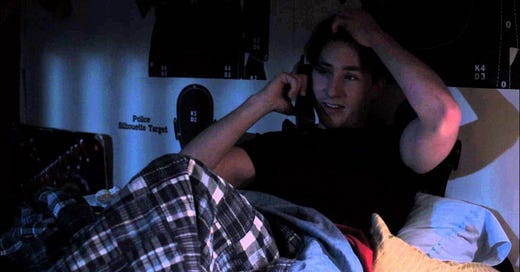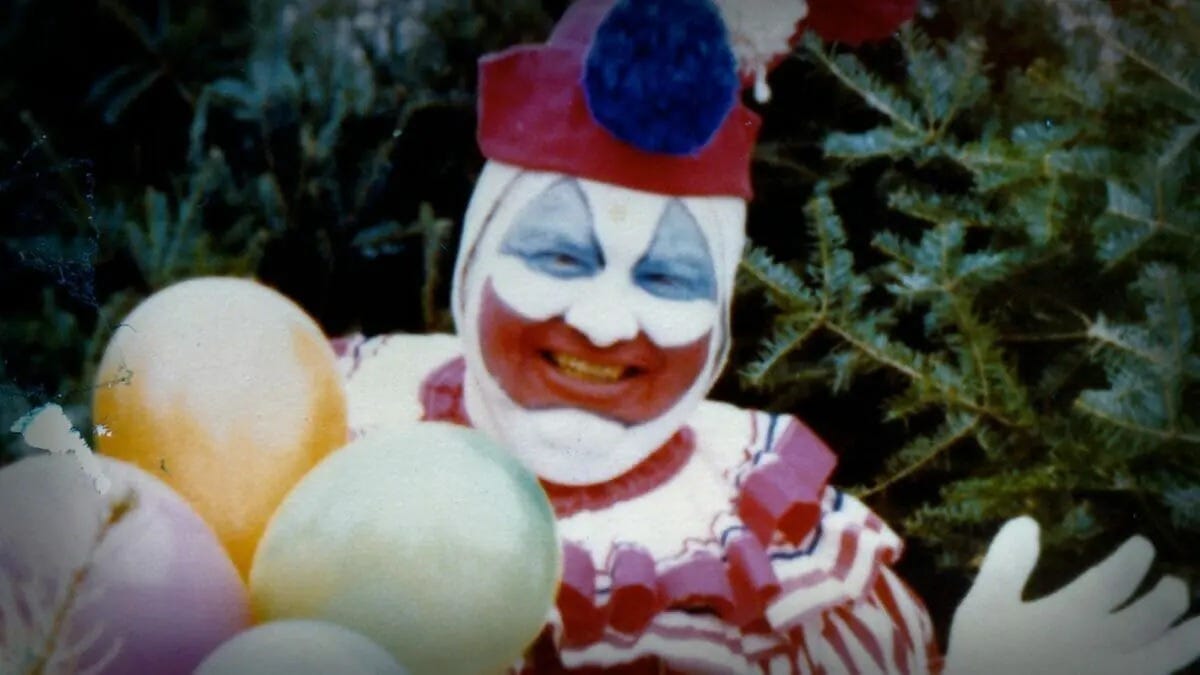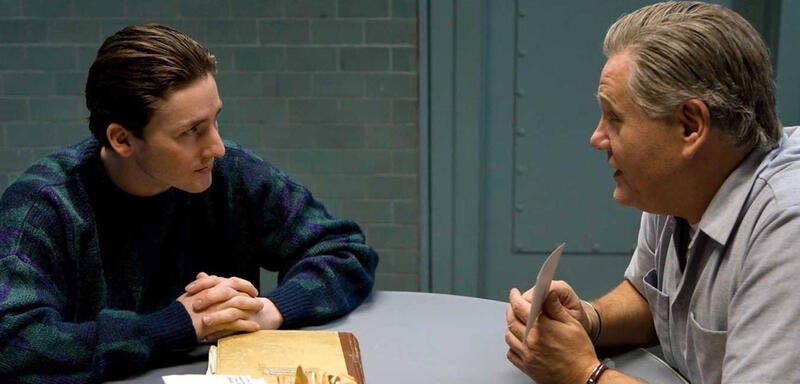Dear Mr. Gacy is the fictionalized account of a young man's fascination with John Wayne Gacy, one of the most infamous serial killers in American history, if not the most prolific. Though famous for his clown garb, Gacy had shown signs of antisocial personality long before performing as a clown, and the attire was unrelated to his crimes though it caught the public's attention. In fact, it is believed Gacy first began performing as a clown after he was released from prison for the assault of a young man in a youth leadership organization he was a part of. Gacy served eighteen months of a ten-year sentence and was released in 1970 to 12-months probation. In 1971, he was charged with the assaults two additional young men, but the charges were dismissed due to failure to appear of one of the victims and the attempted blackmail of Gacy by the other.
Jason Moss, a college student from Long Island, was an honors student in college when he penned a paper on serial killers, including Gacy, for a class. He'd written to Gacy in preparing the paper and met with him twice only months before Gacy's execution. Moss would later use his first-hand account to pen The Last Victim: A True-Life Journey into the Mind of the Serial Killer in 1999, which was later adapted into Dear Mr. Gacy. The film does take some artistic license, showing Jason's interaction with his family who he’s shown living with while in college (Jason actually went to college on the other side of the US, far from his family in Long Island). In terms of strong points, the film succeeds in humanizing both Jason and Gacy, while also showing how problematic they are.
The news media penned the term “The Killer Clown” to refer to Gacy.
In the film, Gacy, played by William Forsythe, initially appears to lure Jason in with his charm and experience. They talk about girls and being a man. It seems as if Jason could be Gacy's next victim if Gacy were to ever be released as the result of an appeal (he was on death row at the time). Jason is having problems with his younger brother being bullied, frustrations around living at home with parents, and tensions with his girlfriend. Jason doesn't flip when Gacy gets his home phone number and calls him collect from prison. They spend many nights talking on the phone into the wee hours of the morning. Gacy even promises to pay the collect charges as he was a comfortable business owner prior to going to prison.
Gacy falls into the pattern of narcissistic manipulation with Jason, but what he doesn't know is that in this scenario he's the victim. Jason is beating Gacy at his own game: finding out what he likes and using that to insinuate himself into Gacy's confidence. Although Gacy denies a same-sex orientation, Jason suspects otherwise and gets his attention with shirtless photos sent to the prison. He goes along when Gacy's phone conversations stray into creepy-coach-hitting-on-his-athletes territory. Gacy has become the prey, and in the process the screenwriter cleverly shows that Gacy has in fact inadvertently created a protege. Jason was just using Gacy for his paper, which he would later turn into a book.
The real John Wayne Gacy would be executed by lethal injection on May 10, 1994 at 12:40 in the morning. For his last meal, Gacy had a bucket of KFC, fried shrimp, and a Diet Coke (among other things). His last words were reportedly "Kiss my ass." But Jason Moss's story wasn't much brighter. He graduated with honors from the University of Nevada, Las Vegas, and then went on to graduate from the University of Michigan Law School, no mean accomplishment. Jason studied many serial killers for his college paper, including Charles Manson and Jeffrey Dahmer, but he said it was Gacy who left the strongest impact. The title Last Victim references Jason's belief that he became Gacy's final victim, but the idea that Gacy was himself lured into confidence by Jason and opened up to him while desperately waiting for an appeal suggests a more complex relationship. Jason reported that he felt manipulated by Gacy, but it seems this might have been a two-way street.
John Wayne Gacy's victims (with ages at death and dates of death)
Timothy Jack McCoy 16 January 3, 1972
John Butkovich 18 July 31, 1975
Darrell Julius Samson 18 April 6, 1976
Randall Wayne Reffett 15 May 14, 1976
Samuel G. Dodd Stapleton 14 May 14, 1976
Michael Lawrence Bonnin 17 June 3, 1976
William Huey Carroll Jr. 16 June 13, 1976
James Byron Haakenson 16 August 5, 1976
Rick Louis Johnston 17 August 6, 1976
Kenneth Ray Parker 16 October 24, 1976
Michael M. Marino 14 October 24, 1976
William George Bundy 19 October 26, 1976
Francis Wayne Alexander 21 December 1, 1976
Gregory John Godzik 17 December 12, 1976
John Alan Szyc 19 January 20, 1977
Jon Steven Prestidge 20 March 15, 1977
Matthew Walter Bowman 19 July 5, 1977
Robert Edward Gilroy Jr. 18 September 15, 1977
John Antheney Mowery 19 September 25, 1977
Russell Lloyd Nelson 21 October 17, 1977
Robert David Winch 16 November 10, 1977
Tommy Joe Boling 20 November 18, 1977
David Paul Talsma 19 December 9, 1977
William Wayne Kindred 19 February 16, 1978
Timothy David O'Rourke 20 June 16–23, 1978
Frank William Landingin 19 November 4, 1978
James Mazzara 20 November 24, 1978
Robert Jerome Piest 15 December 11, 1978
Certainly making no attempt to feel sorry for Gacy here, but it's interesting to consider this idea that predators can themselves become victims, especially in the case of someone as well-known as John Wayne Gacy. Everyone in America would have known of Gacy’s crimes at the time, with the added chorus of the TV news psychoanalysts. And one wonders what precisely Jason and Gacy talked about and whether Dear Mr. Gacy captured the darkness that would have been present in their conversations, though one is inclined to believe that Gacy was trying to win Jason's good will as he repeatedly insisted on his innocence. Jason Moss's book became a New York Times bestseller, though Jason's life took an unfortunate course. It would later be reported that Moss battled depression and some speculated that he dabbled in the occult. His date of death of June 6th, 2006 has done little to dispel those rumors. Jason died of a self-inflicted gunshot wound slightly more than 12 years after Gacy. The film ends with a photo of the real Jason Moss together with John Wayne Gacy, taken a few days before the execution. Because of Dear Mr. Gacy, we learn that even from the confines of a state prison the Killer Clown managed one final performance. I hadn’t heard of Jason Moss until I saw the film and I suspected many others hadn’t either.
Gacy and Jason Moss shortly before Gacy’s execution in 1994.







